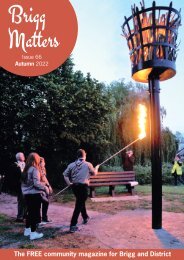Brigg Matters Issue 61 Summer 2021
Brigg Matters Magazine Issue 61 Summer 2021
Brigg Matters Magazine
Issue 61 Summer 2021
Create successful ePaper yourself
Turn your PDF publications into a flip-book with our unique Google optimized e-Paper software.
SUE HOY’S ALLOTMENT<br />
In Search of the Perfect Rose<br />
Nothing says summer quite like the sight and scent of<br />
roses in the garden. Although there are roses in flower<br />
as early as May and as late as October, June is often the<br />
peak time in British gardens, the weeks when they are<br />
at their glorious best. Roses hold a special place in our<br />
affections; it’s the English national flower, the symbol<br />
of romance and there’s nothing to match its voluptuous<br />
abundance in gardens<br />
large and small all<br />
over the country.<br />
We’re all familiar with<br />
the large, high-pointed<br />
blooms of hybrid<br />
tea roses, which are<br />
often used in massed<br />
plantings, but they<br />
are only a small part<br />
of the fabulous rose<br />
story. Roses come in<br />
an amazing range of<br />
vibrant – and more<br />
subtle – colours;<br />
they can be grown<br />
as climbers, shrubs,<br />
ground cover and<br />
miniatures, so there’s<br />
space for a rose in<br />
every garden. So how<br />
do you begin to make<br />
a choice from the<br />
thousands of varieties<br />
and types available?<br />
I’m greedy, and<br />
want to enjoy my<br />
roses for as long a<br />
period as possible,<br />
so I always look for<br />
roses which repeatflower<br />
throughout<br />
the season. Some,<br />
particularly older<br />
varieties, are only in bloom for a few weeks in<br />
midsummer, whilst others flower from May right through<br />
to September – fantastic garden value. I also want scent<br />
in a rose. Although there are some very lovely unscented<br />
roses, for me the perfume makes all the difference,<br />
whether wafting over the garden on a warm summer<br />
day, or enjoyed at close quarters in a vase. By the way,<br />
each rose has its own unique scent, from the orangey,<br />
spiciness of the beautiful climber ‘Albertine’, to the ‘true’<br />
rose scent of ‘Roseraie de l’ Hay’.<br />
It’s also a good idea, if possible, to buy roses that have<br />
some disease resistance. Some of the older roses are<br />
very susceptible to fungal diseases such as rust and<br />
black spot, which are difficult to control, while modern<br />
varieties tend to be<br />
more resistant.<br />
Having said that,<br />
I grow one of the<br />
oldest-known roses,<br />
‘Great Maiden’s<br />
Blush’. It suffers<br />
badly from rust<br />
but I love its palest<br />
pink, flat, quartered<br />
blooms and delicate<br />
scent. Decide too,<br />
how much space<br />
you have; there’s<br />
no point in planting<br />
a very vigorous<br />
climber or rambling<br />
rose, which could<br />
reach 9 metres, on<br />
a bungalow, or a<br />
2-metre shrub rose in<br />
a tiny garden.<br />
Climbers are<br />
particularly useful<br />
in smaller gardens;<br />
wherever ground<br />
space is limited, go<br />
upwards. Climbing<br />
roses can be planted<br />
on fences, house<br />
walls, trellising,<br />
over archways or<br />
even tunnels. All<br />
will add atmosphere<br />
and character to<br />
your garden along with glorious scent and colour. A<br />
good shorter climber, reaching only about 2.5 metres, is<br />
‘Parade’, with a nicely-shaped, deep pink flower; ‘Pink<br />
Perpetué’ is also good.<br />
Among larger climbers, ‘Ginger Syllabub’ is very striking,<br />
with large, amber-pink blooms and good fragrance.<br />
‘Clotted Cream’ also has large blooms with creamy-yellow<br />
54 <strong>Brigg</strong> <strong>Matters</strong><br />
<strong>Brigg</strong> <strong>Matters</strong> 55

















